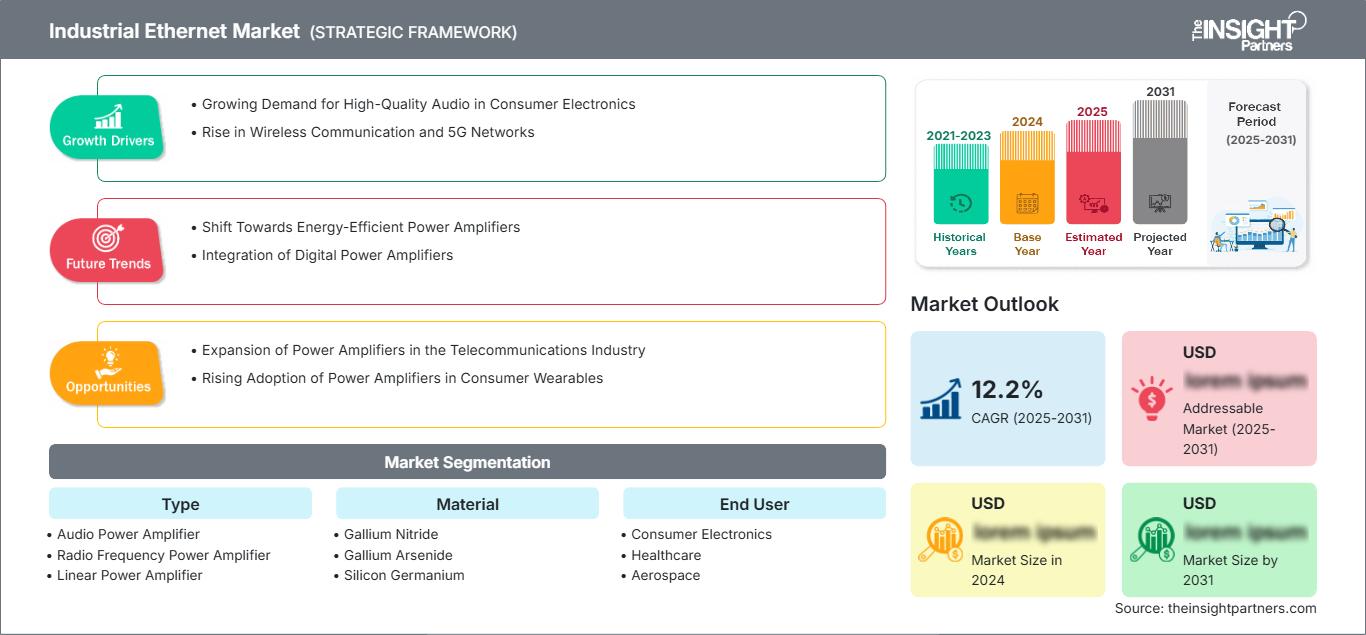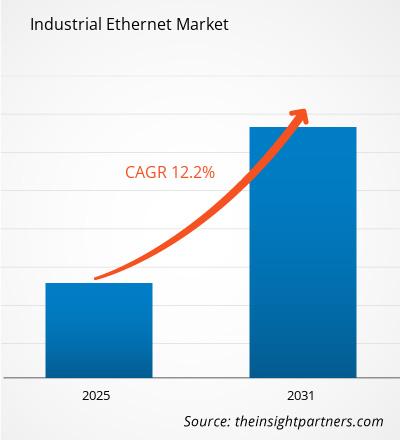Si prevede che il mercato degli amplificatori di potenza registrerà un CAGR del 12,2% dal 2025 al 2031, con una dimensione del mercato in espansione da XX milioni di dollari nel 2024 a XX milioni di dollari entro il 2031.
Il rapporto è segmentato per tipologia (amplificatore di potenza audio, amplificatore di potenza a radiofrequenza (RF) e amplificatore di potenza lineare), materiale (nitruro di gallio (GaN), arseniuro di gallio (GaAs) e silicio-germanio (SiGe)) e utente finale (elettronica di consumo, sanità, aerospaziale e difesa, telecomunicazioni e altri). L'analisi globale è ulteriormente suddivisa a livello regionale e per i principali paesi. Il rapporto offre il valore in USD per l'analisi e i segmenti sopra indicati.
Scopo del rapporto
Il rapporto "Power Amplifier Market" di The Insight Partners mira a descrivere il panorama attuale e la crescita futura, i principali fattori trainanti, le sfide e le opportunità. Ciò fornirà spunti a vari stakeholder aziendali, come:
- Fornitori/produttori di tecnologia: per comprendere le dinamiche di mercato in evoluzione e conoscere le potenziali opportunità di crescita, consentendo loro di prendere decisioni strategiche informate.
- Investitori: per condurre un'analisi completa delle tendenze in merito al tasso di crescita del mercato, alle proiezioni finanziarie del mercato e alle opportunità esistenti lungo la catena del valore.
- Organismi di regolamentazione: per regolamentare le politiche e le attività di controllo nel mercato con l'obiettivo di ridurre al minimo gli abusi, preservare la fiducia degli investitori e sostenere l'integrità e la stabilità del mercato.
Tipo di segmentazione del mercato degli amplificatori di potenza
- Amplificatore di potenza audio
- Amplificatore di potenza a radiofrequenza
- Amplificatore di potenza lineare
Materiale
- Nituro di gallio
- Arseniuro di gallio
- Silicio-germanio
Utente finale
- Elettronica di consumo
- Sanità
- Aerospaziale
- Difesa
- Telecomunicazioni
- Altro
Geografia
- Nord America
- Europa
- Asia-Pacifico
- America meridionale e centrale
- Medio Oriente e Africa
Potrai personalizzare gratuitamente qualsiasi rapporto, comprese parti di questo rapporto, o analisi a livello di paese, pacchetto dati Excel, oltre a usufruire di grandi offerte e sconti per start-up e università
Mercato Ethernet industriale: Approfondimenti strategici

- Ottieni le principali tendenze chiave del mercato di questo rapporto.Questo campione GRATUITO includerà l'analisi dei dati, che vanno dalle tendenze di mercato alle stime e alle previsioni.
Fattori di crescita del mercato degli amplificatori di potenza
- Crescente domanda di audio di alta qualità nell'elettronica di consumo: la crescente popolarità delle apparecchiature audio e video ad alta definizione nell'elettronica di consumo è uno dei principali fattori trainanti per il mercato degli amplificatori di potenza. Con l'avvento di sistemi home theater, console di gioco e apparecchiature audio di fascia alta, cresce la necessità di amplificatori di potenza per migliorare la qualità del suono, offrendo ai consumatori esperienze audio nitide e prive di distorsioni. Questa crescente domanda di suono immersivo sta contribuendo in modo significativo alla crescita del mercato.
- Aumento delle comunicazioni wireless e delle reti 5G: l'implementazione delle reti 5G e la crescente adozione di tecnologie di comunicazione wireless stanno stimolando la domanda di amplificatori di potenza. Questi amplificatori sono essenziali per la trasmissione di segnali su lunghe distanze, soprattutto nei sistemi di comunicazione come stazioni base, smartphone e dispositivi IoT. Con la crescente domanda di connessioni wireless più veloci e affidabili, gli amplificatori di potenza sono fondamentali per garantire il funzionamento efficiente di queste reti.
Tendenze future del mercato degli amplificatori di potenza
- Spostamento verso amplificatori di potenza a basso consumo energetico: una delle tendenze chiave nel mercato degli amplificatori di potenza è la crescente domanda di amplificatori a basso consumo energetico. Con la crescente consapevolezza del consumo energetico e della sostenibilità ambientale, i produttori si stanno concentrando sulla progettazione di amplificatori di potenza che forniscano un'elevata potenza di uscita consumando meno energia. Gli amplificatori di potenza a basso consumo energetico stanno diventando cruciali per le applicazioni nei dispositivi mobili, nelle telecomunicazioni e nell'elettronica di consumo, dove l'efficienza energetica è un fattore critico.
- Integrazione di amplificatori di potenza digitali: un'altra tendenza degna di nota nel mercato è la crescente integrazione di amplificatori di potenza digitali. Questi amplificatori offrono maggiore efficienza, migliore elaborazione del segnale e fattori di forma più piccoli rispetto ai tradizionali amplificatori analogici. Grazie ai progressi nella tecnologia di elaborazione digitale del segnale (DSP), gli amplificatori di potenza digitali vengono utilizzati in diverse applicazioni, come comunicazioni wireless, broadcasting e sistemi audio, consentendo soluzioni più compatte, convenienti e versatili.
Opportunità di mercato per gli amplificatori di potenza
- Espansione degli amplificatori di potenza nel settore delle telecomunicazioni: la crescente domanda di trasferimento dati ad alta velocità, soprattutto con l'espansione delle reti 5G, rappresenta un'opportunità significativa per il mercato degli amplificatori di potenza. Questi amplificatori sono fondamentali per le infrastrutture di telecomunicazione, comprese stazioni base, ripetitori e altre apparecchiature che supportano le comunicazioni wireless. Con gli operatori di telecomunicazioni che investono nell'implementazione del 5G e nell'espansione dei data center, gli amplificatori di potenza saranno essenziali per garantire un'amplificazione del segnale e prestazioni di rete impeccabili.
- Crescente adozione di amplificatori di potenza nei dispositivi indossabili di consumo: la rapida crescita del mercato dell'elettronica indossabile, inclusi smartwatch, fitness tracker e occhiali per realtà aumentata (AR), rappresenta un'opportunità per il mercato degli amplificatori di potenza. Con l'avanzare dell'evoluzione dei dispositivi indossabili, gli amplificatori di potenza vengono sempre più utilizzati per migliorare le prestazioni delle comunicazioni wireless, dell'audio e delle funzioni a batteria. Questa crescente domanda di sistemi audio e di comunicazione portatili ed efficienti crea opportunità significative per i produttori di amplificatori di potenza.
Approfondimenti regionali sul mercato Ethernet industriale
Le tendenze regionali e i fattori che influenzano il mercato Ethernet industriale durante il periodo di previsione sono stati ampiamente spiegati dagli analisti di The Insight Partners. Questa sezione illustra anche i segmenti e la geografia del mercato Ethernet industriale in Nord America, Europa, Asia-Pacifico, Medio Oriente e Africa, America meridionale e centrale.
Ambito del rapporto sul mercato Ethernet industriale
| Attributo del rapporto | Dettagli |
|---|---|
| Dimensioni del mercato in 2024 | US$ XX million |
| Dimensioni del mercato per 2031 | US$ XX Million |
| CAGR globale (2025 - 2031) | 12.2% |
| Dati storici | 2021-2023 |
| Periodo di previsione | 2025-2031 |
| Segmenti coperti |
By Tipo
|
| Regioni e paesi coperti | Nord America
|
| Leader di mercato e profili aziendali chiave |
|
Densità degli operatori del mercato Ethernet industriale: comprendere il suo impatto sulle dinamiche aziendali
Il mercato Ethernet industriale è in rapida crescita, trainato dalla crescente domanda degli utenti finali, dovuta a fattori quali l'evoluzione delle preferenze dei consumatori, i progressi tecnologici e una maggiore consapevolezza dei vantaggi del prodotto. Con l'aumento della domanda, le aziende stanno ampliando la propria offerta, innovando per soddisfare le esigenze dei consumatori e sfruttando le tendenze emergenti, alimentando ulteriormente la crescita del mercato.

- Ottieni il Mercato Ethernet industriale Panoramica dei principali attori chiave
Punti di forza
- Copertura completa: il rapporto analizza in modo esaustivo prodotti, servizi, tipologie e utenti finali del mercato degli amplificatori di potenza, offrendo una panoramica olistica.
- Analisi degli esperti: il rapporto è redatto sulla base della conoscenza approfondita di esperti e analisti del settore.
- Informazioni aggiornate: il rapporto garantisce la pertinenza aziendale grazie alla copertura di informazioni e tendenze dei dati recenti.
- Opzioni di personalizzazione: questo rapporto può essere personalizzato per soddisfare le esigenze specifiche del cliente e adattarsi in modo appropriato alle strategie aziendali.
Il rapporto di ricerca sul mercato degli amplificatori di potenza può quindi aiutare a guidare il percorso di decodificazione e comprensione dello scenario del settore e delle prospettive di crescita. Sebbene possano esserci alcune valide preoccupazioni, i vantaggi complessivi di questo rapporto tendono a superare gli svantaggi.
- Analisi storica (2 anni), anno base, previsione (7 anni) con CAGR
- Analisi PEST e SWOT
- Valore/volume delle dimensioni del mercato - Globale, Regionale, Nazionale
- Industria e panorama competitivo
- Set di dati Excel
Report recenti
Testimonianze
Motivo dell'acquisto
- Processo decisionale informato
- Comprensione delle dinamiche di mercato
- Analisi competitiva
- Analisi dei clienti
- Previsioni di mercato
- Mitigazione del rischio
- Pianificazione strategica
- Giustificazione degli investimenti
- Identificazione dei mercati emergenti
- Miglioramento delle strategie di marketing
- Aumento dell'efficienza operativa
- Allineamento alle tendenze normative




















 Ottieni un campione gratuito per - Mercato Ethernet industriale
Ottieni un campione gratuito per - Mercato Ethernet industriale